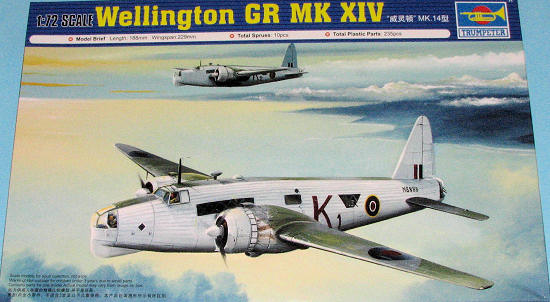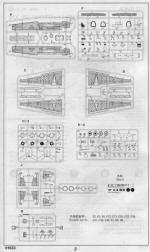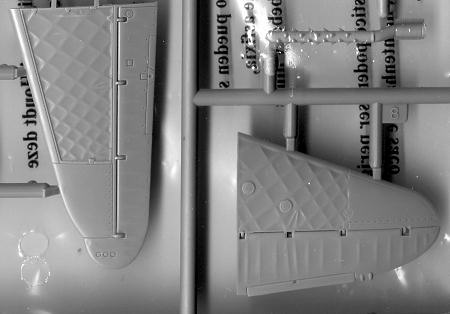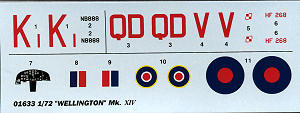
| KIT #: | 01633 |
| PRICE: | $29.95 from GreatModels |
| DECALS: | Two options |
| REVIEWER: | Scott Van Aken |
| NOTES: |

| HISTORY |
The Vickers Wellington was a British twin-engine, long range medium bomber designed in the mid-1930s at Brooklands in Weybridge, Surrey, by Vickers-Armstrongs' Chief Designer, R. K. Pierson. It was widely used as a night-time bomber in the early years of World War II, before being displaced as a bomber by the larger four-engined "heavies" such as the Avro Lancaster. The Wellington continued to serve throughout the war in other duties, particularly as an anti-submarine aircraft. It was the only British bomber to be produced for the entire duration of the war. The Wellington was popularly known as the Wimpy by service personnel, after J. Wellington Wimpy from the Popeye cartoons and a Wellington "B for Bertie" had a starring role in the 1942 propaganda film One of Our Aircraft Is Missing. The Wellington was one of two bombers named for Arthur Wellesley, 1st Duke of Wellington (Victor over Napoleon), the other being the Vickers Wellesley.
The GR.XIV and subject of this kit, was the Maritime version of B Mark X with a chin radome housing the ASV Mark III radar and added RP-3 explosive rocket rails to the wings. The B.X was the most widely produced variant of which 3,804 were built. It was similar to the Mark III except for the 1,675 hp (1,250 kW) Hercules VI or XVI powerplant and a fuselage structure of light alloy, instead of steel.
| THE KIT |
 Prior
to Trumpeter releasing this series of 1/72 Wellingtons, the best kit on the
market was the MPM/Special Hobby versions. Not to say that the really old
Matchbox and Airfix kits are bad, they are just really old mold technology. Now
Trumpeter has often been taken to task by having overly exaggerated surface
detailing on some of their kit. It definitely applies to this one. Sorry folks,
but there is a difference between subtle rib and frame detailing and that which
is overly do
Prior
to Trumpeter releasing this series of 1/72 Wellingtons, the best kit on the
market was the MPM/Special Hobby versions. Not to say that the really old
Matchbox and Airfix kits are bad, they are just really old mold technology. Now
Trumpeter has often been taken to task by having overly exaggerated surface
detailing on some of their kit. It definitely applies to this one. Sorry folks,
but there is a difference between subtle rib and frame detailing and that which
is overly do  ne.
This one is about at subtle as Rush Limbaugh at a Rainbow Coalition Convention.
It is just way overdone as you can see from this detail shot. Doesn't mean that
is it impossible, as a light sanding will remove much of the offensive overkill.
So may a good coat of paint. But some would rather not have to deal with it at
all. So now that this is out of the way, let's take a peek at the rest of the
kit.
ne.
This one is about at subtle as Rush Limbaugh at a Rainbow Coalition Convention.
It is just way overdone as you can see from this detail shot. Doesn't mean that
is it impossible, as a light sanding will remove much of the offensive overkill.
So may a good coat of paint. But some would rather not have to deal with it at
all. So now that this is out of the way, let's take a peek at the rest of the
kit.
Trumpeter has gone a long way to providing a well detailed kit. There are a couple of sprues that are doubled up and so we have wheels and props, for instance, that are not going to be needed on this one. Oddly, Trumpeter does not mark them out on the sprues page as do many other companies so be careful to watch the required part numbers. The kit has a nicely detailed cockpit with chairs and control wheels and rudder pedals as well as a radio operator and navigator's compartment. While there is sidewall an panel detail, the main instrument panel is a decal. There is a full geodesic framework inside the fuselage, most of which will not be seen. It has also caused a few sink areas in one fuselage half. This framework should also be easily seen behind the long fuselage windows, yet these are crystal clear and void of this feature. While on the subject of clear bits, the rear turret is split in half and so has a seam that falls on a 'panel line'. Fortunately for most, there is no front turret to worry about.
Engines are nicely done and somewhat generic as is frequently the case in 1/72. There are very nicely done wheel wells and the gear looks well detailed and should be sturdy. There is a bomb bay with a closed door section to fit in there once the fuselage halves are together. Though boxed as a 'torpedo bomber', no ordnance is included and really, no hinges for the bay doors even if you wanted to pose them open. Kind of makes it a bit of a waste as there is considerable detail in the bays themselves. Oh well. An interesting mechanism for attaching the wings is provided. There is a boxed piece that nearly butt joins to the wing roots via two small alignment pins. Then the wing is joined to this 'mini-spar' for the final alignment. First I've seen of this and I guess it works. Fin and horizontal stabs fit via the usual tab and slot sort of thing.
 Instructions
are well done with Gunze paint references. Markings for two identically painted
planes in dark green/dark sea grey over white. Coastal Command planes were
uniformly boring and consisted of insignia, serials and codes. Yawn. The box art
plane is from 458 Squadron in Algeria during 1943 while the other, coded QD*V is
from 304 Sq in 1944. Apparently Coastal Command Wimpeys had the squadron codes
aft of the roundel on both sides. The decal sheet is well printed and while the
yellow seems a bit transparent, should provide no surprises as it will be on a
white background.
Instructions
are well done with Gunze paint references. Markings for two identically painted
planes in dark green/dark sea grey over white. Coastal Command planes were
uniformly boring and consisted of insignia, serials and codes. Yawn. The box art
plane is from 458 Squadron in Algeria during 1943 while the other, coded QD*V is
from 304 Sq in 1944. Apparently Coastal Command Wimpeys had the squadron codes
aft of the roundel on both sides. The decal sheet is well printed and while the
yellow seems a bit transparent, should provide no surprises as it will be on a
white background.
| CONCLUSIONS |
So there you have it. Another Wellington option for you if you are a fan.. Now if Trumpeter wanted to get really adventurous, they'd do a Mk VI. Look it up.
| REFERENCES |
April 2009
You can get this kit as well as other fine kits and accessories at www.greatmodels.com
If you would like your product reviewed fairly and quickly, please contact me or see other details in the Note to Contributors.